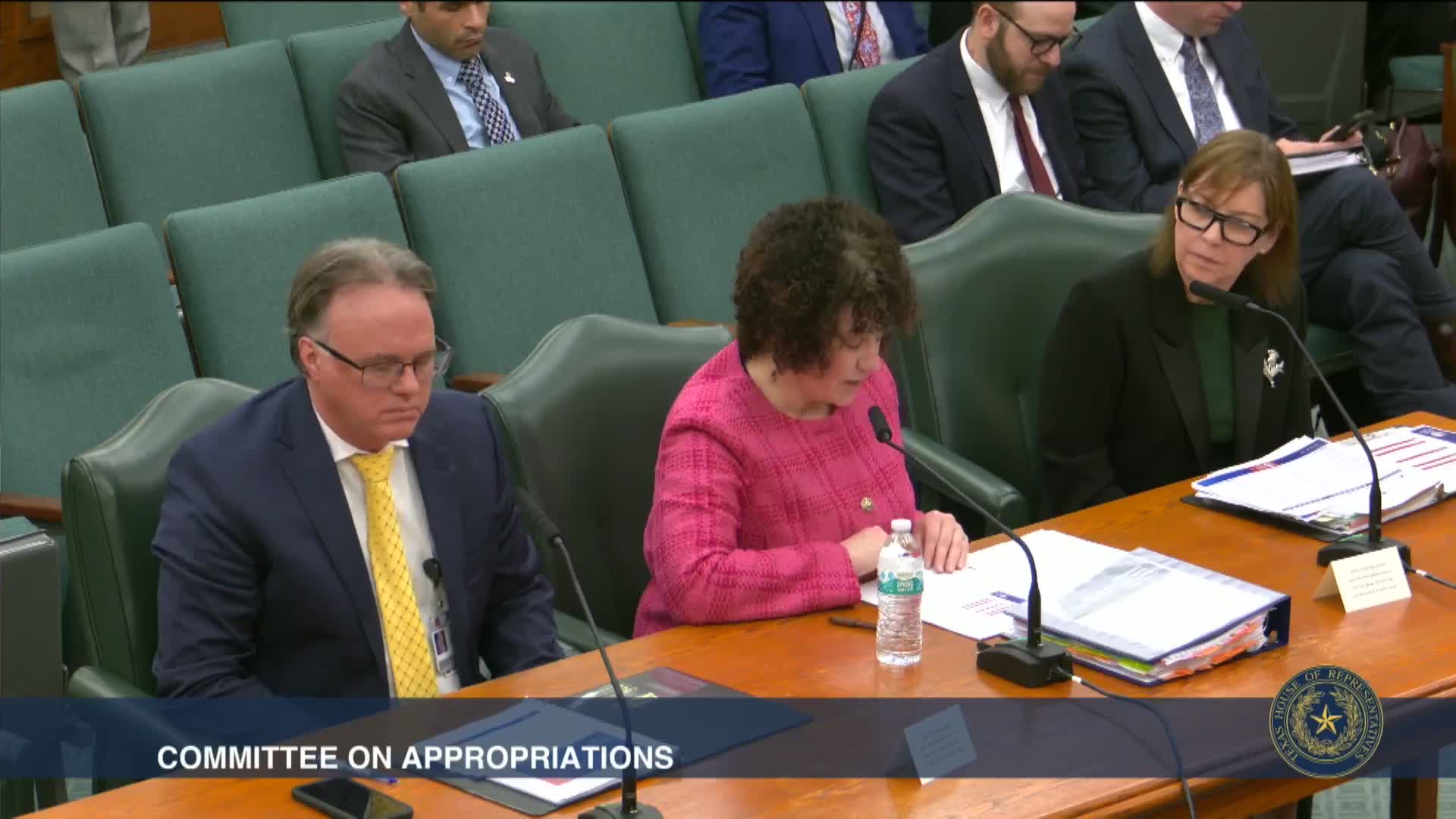DFPS: community‑based care rollout continues; agency uses temporary stabilization sites to reduce children‑without‑placement numbers
February 18, 2025 | Committee on Appropriations, HOUSE OF REPRESENTATIVES, Legislative, Texas
This article was created by AI summarizing key points discussed. AI makes mistakes, so for full details and context, please refer to the video of the full meeting. Please report any errors so we can fix them. Report an error »

NOTE: (Shortened because of schema size limits) DFPS Commissioner Stephanie Muth told the House Appropriations Committee the agency is continuing the staged rollout of community‑based care (CBC) and outlined measures to address “children without placement” (youth the agency has custody of but for whom it has not obtained a placement after the second night).
Community‑based care progress
Muth said CBC is implemented in multiple catchment areas and that the department uses a three‑stage readiness model: Stage 1 (placement responsibility), Stage 2 (case management responsibility), and Stage 3 (performance‑based contracting with remedies and incentives). She said most contracted areas are moving through the stages and that contract awards for certain urban catchments (including Bexar and Houston areas) were pending at the time of the briefing; El Paso and Midland‑Odessa had attracted no bids and DFPS had requested public input to refine the approach for geographically large rural areas.
Children without placement (CWAP)
Muth presented data showing most youth who experience being without placement are 14 or older and a substantial share entered DFPS custody within the prior year; many have behavioral‑health and juvenile justice histories. DFPS said the agency reduced its CWAP numbers substantially from a pandemic peak through intensive case‑by‑case staffing, coordination with HHSC and local mental‑health authorities, and new strategies such as leasing a short‑term stabilization site to provide a consistent supervised environment for a small number of youth while a longer‑term placement is identified. The department acknowledged the model is not a long‑term substitute for clinical residential treatment capacity and asked appropriators to consider investments that support local provider capacity, step‑down programs, and kinship supports.
T3C (rate modernization)
Muth described the department’s transition to Texas Child‑Centered Care (T3C), a rate modernization and service‑package approach that replaces a decades‑old rate structure with 27 service packages and an assessment‑driven placement model. T3C credentials for providers began in January; DFPS reported dozens of providers have applied and some have received interim credentials. Muth asked the committee to consider transition funding previously requested so providers can implement the new service packages and align staffing, clinical supports and documentation systems.
Workforce and pay
DFPS said it continues to monitor staff retention, pay compression and recruitment; the agency requested targeted pay adjustments in the LAR for key classifications and asked the committee to consider funding to lower caseloads and expand supports for staff safety and secondary‑trauma care.
Ending
DFPS urged appropriators to support operating dollars for new CBC regions and to consider investments that will expand local placements, crisis diversion, and workforce capacity so the department can sustain progress and reduce pressure on jails and emergency settings.
Community‑based care progress
Muth said CBC is implemented in multiple catchment areas and that the department uses a three‑stage readiness model: Stage 1 (placement responsibility), Stage 2 (case management responsibility), and Stage 3 (performance‑based contracting with remedies and incentives). She said most contracted areas are moving through the stages and that contract awards for certain urban catchments (including Bexar and Houston areas) were pending at the time of the briefing; El Paso and Midland‑Odessa had attracted no bids and DFPS had requested public input to refine the approach for geographically large rural areas.
Children without placement (CWAP)
Muth presented data showing most youth who experience being without placement are 14 or older and a substantial share entered DFPS custody within the prior year; many have behavioral‑health and juvenile justice histories. DFPS said the agency reduced its CWAP numbers substantially from a pandemic peak through intensive case‑by‑case staffing, coordination with HHSC and local mental‑health authorities, and new strategies such as leasing a short‑term stabilization site to provide a consistent supervised environment for a small number of youth while a longer‑term placement is identified. The department acknowledged the model is not a long‑term substitute for clinical residential treatment capacity and asked appropriators to consider investments that support local provider capacity, step‑down programs, and kinship supports.
T3C (rate modernization)
Muth described the department’s transition to Texas Child‑Centered Care (T3C), a rate modernization and service‑package approach that replaces a decades‑old rate structure with 27 service packages and an assessment‑driven placement model. T3C credentials for providers began in January; DFPS reported dozens of providers have applied and some have received interim credentials. Muth asked the committee to consider transition funding previously requested so providers can implement the new service packages and align staffing, clinical supports and documentation systems.
Workforce and pay
DFPS said it continues to monitor staff retention, pay compression and recruitment; the agency requested targeted pay adjustments in the LAR for key classifications and asked the committee to consider funding to lower caseloads and expand supports for staff safety and secondary‑trauma care.
Ending
DFPS urged appropriators to support operating dollars for new CBC regions and to consider investments that will expand local placements, crisis diversion, and workforce capacity so the department can sustain progress and reduce pressure on jails and emergency settings.
View full meeting
This article is based on a recent meeting—watch the full video and explore the complete transcript for deeper insights into the discussion.
View full meeting
